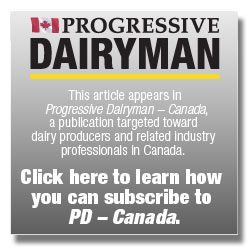The developing horns of dairy calves are typically removed to reduce the risk of injuries to farm workers or other cattle later in life. Horns of calves 3 months old or older are normally removed surgically (“dehorning”) by scooping, shearing or sawing. Horn buds of younger calves are typically removed (“disbudding”) using a caustic paste or a hot iron. There is scientific evidence that all of these methods cause immediate pain and post-operative pain. The immediate pain can be reduced using a local anesthetic to provide a nerve block – this procedure has been used safely for decades and costs just pennies a shot. Pain can persist 24 hours or more – this longer-lasting pain can be reduced using non-steroidal anti-inflammatory drugs (like the ibuprofen you take for a headache). Providing calves a sedative before the procedure can reduce handling stress and make the procedure easier to carry out.
According to the most recent survey, only about 18 percent of dairy farms in the U.S. report use of pain-relieving drugs for disbudding or dehorning dairy calves, meaning that many calves receive no pain control. Is this OK?
Researchers at The University of British Columbia (UBC) have been using Web-based “town hall” meetings to provide opportunities for people in the dairy industry to discuss this and other hot topics with each other and with members of the public interested in these issues.
The UBC’s CowViews site provides the opportunity for people to state their views and also vote on the views of others. The idea is to get people discussing uncomfortable issues in dairy farming and to allow farmers to make more informed decisions about management on their farms.
Over the past few months, people that visited the CowViews site have been able to answer the question, “Should we provide pain relief for disbudding and dehorning dairy calves?” More than 200 people participated in five different virtual town hall meetings.
Every participant “voted” (Yes, Neutral or No) and provided a reason for their vote or chose one or more of the reasons left by other participants in the forum.
The majority of participants (86 percent) responded “Yes;” just 7 percent “Neutral” and 7 percent “No.” Within each virtual town hall meeting, participants could see each other’s responses, but participants in one meeting could not see the reasons discussed in other meetings – in this way each meeting provided an independent test of how this type of discussion unfolds.
Also, an especially persuasive reason can only influence the votes within a single town hall meeting.
Within each of the virtual town hall meetings, the majority of people (from 82 to 90 percent) indicated that pain control is required (i.e. voted “Yes”). Responses did vary with participant demographics – for example, 64 percent of producers voted “Yes” in comparison with a 90 percent “Yes” vote for veterinarians. However, across all demographic categories the majority argued that pain control was required.
These results show a clear disconnect between current practice (with many farmers failing to provide pain control) and the attitudes of participants (including dairy producers) in these virtual town hall meetings.
Causing pain to animals under our care, especially when this pain can easily be prevented, no longer seems acceptable. Our challenge is to find ways of getting pain control techniques applied widely on dairy farms. PD
Daniel M. Weary is a professor and NSERC Industrial Research Chair with the University of British Columbia’s animal welfare program. Nina von Keyserlingk is also a professor with the University of British Columbia's animal welfare program.

Daniel M. Weary
Animal Welfare Program
University of British Columbia








